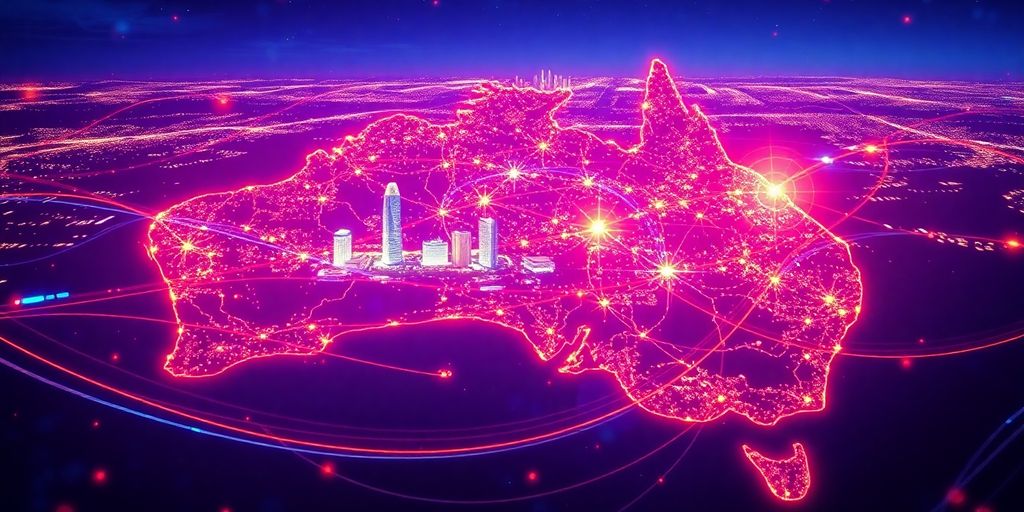Trying to figure out what sort of internet speeds you can expect across Australia? It’s a bit of a mixed bag, really. We’ve had a look at the latest figures to give you a clearer picture of how things are shaping up, from state to state and even day to day. So, whether you’re gaming, streaming, or just trying to get some work done, here’s what the average internet speeds Australia is seeing right now.
Key Takeaways
- Queensland is currently leading the pack when it comes to download speeds.
- Tuesday seems to be the sweet spot for getting the best internet performance.
- Late night hours, specifically between midnight and 4 am, offer the fastest download speeds.
- The average download speed across Australia is sitting around 58.9Mbps.
- Most Aussies are sticking with the NBN 50 plan, but more people are looking at faster options.
Understanding Average Internet Speeds Australia
So, you’re probably wondering what kind of internet speeds we’re actually getting here in Australia. It’s a fair question, especially when you’re trying to stream your favourite show or get some work done. Understanding the average speeds is the first step to figuring out if your internet is up to scratch. We’ll break down what the numbers mean and how they’re measured.
Key Statistics on Australian Internet Performance
When we talk about internet speeds, it’s usually broken down into download and upload speeds. Download is what you use to get stuff from the internet to your device – think streaming videos or loading web pages. Upload is the opposite, sending data from your device to the internet, like uploading photos or making video calls. It’s important to know both.
Here’s a general idea of how things stacked up recently:
- Mobile Download Speeds: Generally quite zippy for everyday browsing and streaming.
- Fixed Broadband Download Speeds: Often more consistent and can be faster for heavy usage.
- Upload Speeds: Typically lower than download speeds across the board, but crucial for video conferencing and uploading large files.
Methodology for Speed Testing
How do we even get these numbers? Well, companies like Speedtest.net use a pretty straightforward method. They have servers all over the world, and when you run a test, your device connects to the closest one. It then sends and receives data to measure how quickly that connection happens.
The results can vary a bit depending on the time of day, the server you connect to, and even the device you’re using. It’s not an exact science, but it gives a good general picture.
These tests are usually done by everyday people like you and me, so it reflects real-world performance. The data is then collected and averaged out to give us these national figures. It’s a good way to see how your own speeds compare to the rest of the country. For example, the NBN very high speed services have shown impressive results in recent tests.
State-by-State Internet Speed Comparisons
When you look at internet speeds across Australia, there are some pretty noticeable differences between the states and territories. It’s not just a little bit different either; some places are getting speeds that are significantly faster than others. This really impacts everything from streaming your favourite shows to getting work done online.
Queensland Leads in Download Speeds
Queensland has been doing quite well lately, often topping the charts for download speeds. People living here are generally getting a pretty good deal when it comes to how fast they can pull data down from the internet. It means smoother streaming and quicker downloads for most.
South Australia and Western Australia Performance
South Australia and Western Australia are also showing some solid performance. While they might not always be at the very top, they’re consistently in the middle to upper range for download speeds. This means a reliable internet experience for many residents in these large states.
ACT Experiences Slowest Download Speeds
Unfortunately, the Australian Capital Territory (ACT) often finds itself at the lower end of the speed rankings. This can be frustrating for residents who might be paying for decent speeds but not actually getting them. It’s a bit of a letdown when you consider it’s the nation’s capital.
The differences in speeds between states aren’t just random; they can be influenced by a lot of factors, including the rollout of the National Broadband Network (NBN) infrastructure and the density of the population in different areas. It’s a complex picture.
Here’s a general idea of how things have been stacking up:
- Queensland: Often leading the pack with the fastest average download speeds.
- South Australia: Consistently performing well, usually in the top half.
- Western Australia: Similar to South Australia, offering good speeds for most users.
- New South Wales: Generally sits in the middle, with variations across the state.
- Victoria: Also tends to be in the middle range, with some areas performing better than others.
- Tasmania: Often experiences slower speeds compared to mainland states.
- Northern Territory: Frequently reports the slowest average speeds across the country.
- ACT: Despite its central role, it often ranks among the slowest for download speeds.
Peak and Off-Peak Internet Speeds

Ever notice how your internet seems to crawl sometimes, especially when everyone else is online? That’s pretty normal, actually. Internet speeds aren’t static; they change throughout the day depending on how many people are using the network. Think of it like traffic on a highway – more cars mean slower travel times.
Fastest Download Speeds Overnight
If you’re a night owl or just an early riser, you’re in for a treat. Our data shows that the absolute best time to get your downloads done or have a smooth streaming session is between midnight and 4 AM. During these quiet hours, average download speeds can jump significantly, often reaching speeds well above the daily average. This is when the network has the least amount of traffic, allowing your connection to perform at its peak. It’s a great time to tackle large files or update games.
Slowest Download Speeds in the Morning
On the flip side, the morning rush hour for internet usage typically hits between 7 AM and 10 AM. This is when most people are waking up, checking emails, getting news updates, and perhaps starting their workday or school day online. As a result, speeds tend to dip during this period. You might find that streaming buffers more or downloads take longer. If you have important online tasks that require a stable, fast connection, it’s usually best to avoid this window if possible. For those looking to improve their home internet, understanding these peak and off-peak times can help manage expectations and even inform choices about internet plans, like considering a provider known for good off-peak performance.
Mobile vs. Fixed Broadband Speeds
When you’re looking at internet speeds in Australia, it’s not just about comparing different providers or plans. You also need to think about how you’re connecting in the first place – are you using your phone’s data or a home broadband connection?
Mobile Download Speed Performance
Generally speaking, mobile internet tends to offer faster download speeds compared to fixed broadband. This is often because the infrastructure for mobile networks has seen significant investment and upgrades. Think about it: you can usually stream videos or download files pretty quickly on your phone when you’re out and about. This means for quick downloads on the go, mobile often has the edge.
Fixed Broadband Upload Speed Advantage
While mobile might win on download speeds, fixed broadband often pulls ahead when it comes to upload speeds. Upload speed is what you need for things like video calls, uploading large files to cloud storage, or even posting videos to social media. If you do a lot of this kind of stuff, a good fixed broadband connection will likely serve you better. It’s a bit of a trade-off, really. You get speed on mobile for downloading, but a more stable and often faster upload experience with your home internet.
Here’s a quick look at how they generally stack up:
- Mobile: Great for downloads, especially when you’re out and about.
- Fixed Broadband: Often better for uploads, which is important for video calls and sending files.
It’s worth remembering that these are averages. Your actual experience can depend a lot on your specific location, the provider you’re with, and even the time of day you’re using the internet. So, while mobile might be faster for downloads on average, your home NBN connection could still be the better choice for overall reliability and specific tasks like uploading.
NBN Speed Tier Popularity
When you’re looking at getting connected to the National Broadband Network (NBN), you’ll notice there are a few different speed tiers available. It’s not a one-size-fits-all situation, and what most people are signing up for can tell us a bit about what Australians generally need from their internet.
NBN 50 as the Most Common Speed Tier
Right now, the NBN 50 plan seems to be the go-to for a lot of households across Australia. It’s the most popular choice, making up a significant chunk of connections. This tier offers a decent balance between speed and cost, which is probably why it appeals to so many.
Shifting Preferences Towards Higher Speed Tiers
However, things are starting to change a little. While NBN 50 is still king, there’s a growing interest in faster plans. This shift might be because the price difference between NBN 50 and the next tier up, NBN 100, has become smaller lately, especially after some price adjustments late last year. People are starting to see the value in paying a bit more for a noticeable speed boost.
Adoption of Ultra-Fast NBN Plans
On the other end of the spectrum, the really high-speed plans, like NBN 250 and NBN 1000, are still quite niche. Only a small percentage of people are opting for these top-tier speeds. It seems most Australians are happy with speeds that let them stream, browse, and game without too much fuss, and the ultra-fast options are still a bit of a luxury for the few.
It’s interesting to see how usage habits and the cost of different plans influence what people choose. As more people get used to faster speeds, we might see even more movement towards the higher NBN speed tiers in the future.
Here’s a quick look at how the popularity stacks up:
- NBN 50: The most common choice for many.
- NBN 100: Gaining traction as the price gap narrows.
- NBN 250/1000: Still a small segment of the market.
Understanding these NBN speed tiers helps you figure out what might be best for your own internet needs.
Optimising Your Internet Experience

So, you’ve checked your speeds and maybe you’re not getting what you expected. Don’t stress, there are a few things you can do to try and get a bit more out of your connection. It’s not always about getting a faster plan, sometimes it’s just about making sure you’re using what you’ve got as well as you can.
Best Day for Internet Usage
When you’re online can make a difference. Think about it, if everyone in your neighbourhood is streaming movies or downloading big files at the same time, your connection might slow down a bit. Generally, weekdays tend to be a bit less congested than weekends. Early mornings or late nights are often quieter too. So, if you’ve got a big download or an important video call, try doing it during off-peak hours.
Understanding Speed Tier Costs
Choosing the right speed tier for your NBN plan is a bit of a balancing act. You want enough speed for what you do online, but you don’t want to pay for more than you need. The most common plan, NBN 50, seems to hit the sweet spot for a lot of Aussies, offering decent speeds for everyday tasks like browsing, streaming, and a bit of online gaming. But if you’ve got a bigger household or you’re constantly downloading large files, you might find yourself needing to step up to NBN 100 or even higher. It’s worth looking at your current usage and comparing the price difference between tiers. Sometimes, the jump isn’t as big as you’d think, and the performance boost can be well worth it. Remember, you can always check out home wireless broadband deals if you’re considering alternatives.
It’s easy to get caught up in wanting the absolute fastest speed, but often, a mid-tier plan is perfectly adequate for most households. Focus on what you actually do online day-to-day.
So, What’s the Go with Internet Speeds in Australia?
Alright, so we’ve had a look at the numbers. It seems like Queensland is leading the pack for download speeds, which is pretty neat if you’re over there. Most of us are getting around 59.8Mbps on average, which is okay for everyday stuff like browsing and streaming. If you’re after the fastest speeds, try doing your big downloads late at night, between midnight and 4am. And if you’re wondering about your NBN plan, most Aussies are sticking with the NBN 50 plan, though it’s worth keeping an eye on prices as NBN 100 gets a bit cheaper. Overall, things are ticking along, but there’s always room for improvement, right?
Frequently Asked Questions
Which Aussie state has the fastest internet?
Queensland is currently leading the pack when it comes to internet speeds across Australia, with an average download speed of 70.5Mbps. South Australia and Western Australia aren’t too far behind, nabbing second and third spots respectively.
When is the best time to use the internet?
If you’re a night owl, you’re in luck! The fastest internet speeds in Australia are usually between midnight and 4am, hitting an average of 74.2Mbps. So, it’s the perfect time to download those big files or stream without a hitch.
When are internet speeds the slowest?
Unfortunately, the early birds might find their internet a bit sluggish. The slowest download speeds tend to happen between 4am and 8am, averaging around 54.3Mbps. Maybe save your major downloads for later in the day!
Is mobile internet faster than home broadband?
In July 2022, mobile internet download speeds were actually faster than fixed broadband. However, when it came to uploading, fixed broadband had a slight edge. So, it depends on what you’re doing online!
What’s the most popular NBN speed plan?
The most common NBN speed plan that Aussies are signed up for is NBN 50. It’s the go-to for many, although people are starting to look at faster plans like NBN 100 as the price difference shrinks.
Are people using the fastest NBN plans?
While NBN 50 is the most popular, there’s a growing interest in faster plans. Only a small percentage, about 2.9%, are using the super-fast NBN 250 or NBN 1000 plans. It seems most Aussies are happy with the middle ground for now.





